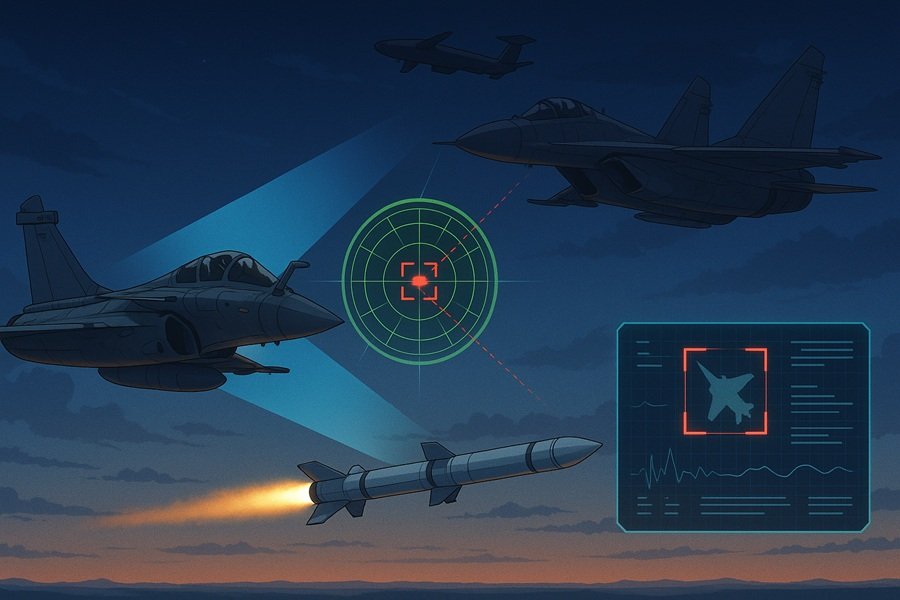
Introduction: The Evolution of Aerial Warfare
Air combat has come a long way from the days of World War I dogfights. In the modern era, aircraft no longer need to see each other to engage in lethal confrontations. This transformation is due to BVR (Beyond Visual Range) combat — a method of air warfare where targets are detected and engaged at distances far beyond the pilot’s visual range, often over 50 to 150 kilometers.
BVR combat represents the cutting edge of aerospace defense strategy, involving advanced radar, electronic warfare, long-range missiles, and stealth technology.
What is BVR Combat?
BVR (Beyond Visual Range) combat refers to aerial engagements between fighter jets where missiles are fired at targets that are not visible to the naked eye. These encounters depend heavily on:
- Airborne Radar
- Infrared Search and Track (IRST)
- Electronic Countermeasures (ECM)
- Networked data sharing
- Radar-guided missiles (e.g., AMRAAM, Astra, Meteor)
Key Characteristics:
- Engagement distance: 20–150+ km
- No visual confirmation before firing
- Heavy dependence on radar and sensors
- Risk of electronic interference and decoys
- Requires high pilot situational awareness and software support
BVR vs WVR Combat
| Feature | BVR Combat | WVR (Within Visual Range) Combat |
|---|---|---|
| Range | 20–150+ km | Less than 5 km |
| Weapons | Radar-guided missiles | Heat-seeking missiles, guns |
| Target Visibility | Not visible | Visual contact needed |
| Tactics | Sensor fusion, jamming, AWACS support | Maneuverability, dogfighting |
| Pilot Skill | Sensor/data interpretation | Close combat agility |
While WVR combat is cinematic and often associated with dogfights, modern air dominance depends more on BVR capabilities, which reduce risk and increase kill probability.
How BVR Combat Works
1. Detection
Detection is typically achieved via Active Electronically Scanned Array (AESA) radar, onboard radar, or AWACS (Airborne Warning and Control System).
2. Target Lock
Once detected, the target is tracked using radar or infrared sensors. Stealth aircraft may rely more on passive detection systems to avoid detection.
3. Missile Launch
A Beyond Visual Range missile is fired — often with a two-phase flight:
- Mid-course phase: Guided by radar or datalink
- Terminal phase: Activates its own seeker (active radar or IR)
4. Post-launch Monitoring
Pilots or AWACS continue tracking the target, providing mid-course updates until the missile activates its terminal seeker.
Famous BVR Missiles in the World
| Missile | Country | Range | Guidance | Speed |
|---|---|---|---|---|
| AIM-120 AMRAAM | USA | ~160 km | Active radar | Mach 4 |
| Meteor | Europe | >200 km | Active radar + datalink | Mach 4+ |
| R-77 (AA-12 Adder) | Russia | 110–175 km | Active radar | Mach 4 |
| PL-15 | China | ~200–300 km | Active radar | Mach 4+ |
| Astra Mk-I/II | India | 110–160 km | Active radar | Mach 4.5 |
The Meteor missile is widely regarded as one of the most advanced BVR missiles due to its ramjet propulsion and “no-escape zone“ concept.
Read this: Meteor Missile vs AMRAAM: Which is the Superior BVR Air-to-Air Missile?
India and BVR Capabilities
Indian BVR Missiles:
- Astra Mk-I: India’s first indigenous BVR missile, now in service with Su-30MKI and Tejas.
- Astra Mk-II and Mk-III: Under development, with improved range and electronic counter-countermeasures (ECCM).
Imported Missiles:
- Derby ER: Integrated on Tejas for IAF.
- MICA (France): Deployed on Mirage-2000 and Rafale.
- Meteor: Rafale-exclusive BVR missile with unmatched capabilities in Asia.
Platforms:
| Aircraft | BVR Capability |
|---|---|
| Su-30MKI | Astra, R-77 |
| Mirage-2000 | MICA |
| Rafale | Meteor, MICA |
| Tejas Mk1A | Astra, Derby |
Read This: India’s Missile Arsenal Explained: Strategic Might of the Subcontinent
Challenges in BVR Combat
1. Electronic Warfare
BVR engagements are vulnerable to jamming, decoys, and radar spoofing, making it a complex electronic battlefield.
2. Rules of Engagement (RoE)
Pilots often require positive identification (PID) before firing — not always possible in BVR. This affects real-world applicability unless wartime rules are relaxed.
3. Stealth and Counter-stealth
Fifth-generation fighters like the F-35, Su-57, and J-20 are designed to evade radar detection, making BVR combat harder to execute unless integrated with space-based ISR (Intelligence, Surveillance, Reconnaissance) systems.
4. Pilot Workload
Managing radar, threat detection, missile behavior, and situational awareness in BVR combat increases pilot cognitive load — mitigated through AI assistance and cockpit automation.
Technological Trends in BVR Warfare
- Artificial Intelligence: Autonomous target recognition and kill chain acceleration.
- Network-Centric Warfare: Sharing target data between aircraft, AWACS, and ground stations.
- LOAL Missiles: Lock-on-after-launch capability allows more flexible engagements.
- Hypersonic Missiles: Next-gen BVR weapons that are almost impossible to intercept.
- Stealth Drone Swarms: Acting as forward sensors and decoys in BVR combat zones.
Famous BVR Engagements
Kargil War (1999)
- India used MiG-29s with R-77s and Mirage-2000s with radar-guided missiles for air dominance, although no BVR kill was officially confirmed.
Balakot Airstrike (2019)
- IAF’s MiG-21 Bison vs PAF’s F-16 — Pakistan claims BVR usage (AIM-120), but India disputes missile impact.
These incidents highlighted the importance of BVR capability, electronic surveillance, and precision targeting.
Conclusion: BVR – The Future of Air Combat
BVR combat has redefined how wars are fought in the skies. Unlike traditional dogfights, it’s a battle of sensors, stealth, data, and split-second decisions made often without ever seeing the enemy.
With the emergence of fifth-generation fighters, indigenous missiles like Astra, and long-range surveillance, India and other air powers are increasingly investing in BVR superiority as a key element of national defense.







